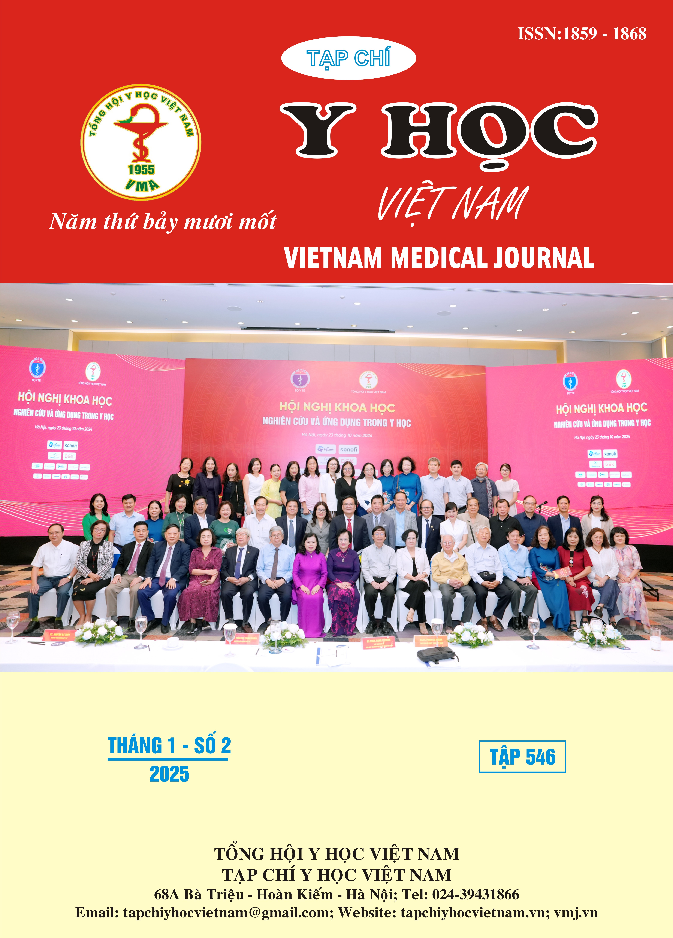THE VALUE OF RETICULOCYTE-RELATED INDICES IN PREDICTING IRON DEFICIENCY IN NON-DIALYSIS CHRONIC KIDNEY DISEASE PATIENTS
Main Article Content
Abstract
Objectives: To assess the predictive value of reticulocyte indices in identifying iron deficiency among non-dialysis CKD patients. Materials and methods: This cross-sectional analytical study included 100 non-dialysis CKD patients undergoing inpatient treatment at the Department of Nephrology and Hemodialysis, Kien Giang General Hospital, from April 2023 to April 2024. Results: The median values for reticulocyte indices were as follows: RET# (82.8 g/L), Ret% (2.1%), CHr (27.9 pg), CHCMr (23.2 g/L), and Ret_Hb (1.57 g/dL). The area under the ROC curve (AUC) for CHr-MCV was 0.798 (95% CI: 0.712-0.885), which was higher than that for CHr at 0.777 (95% CI: 0.685-0.869), with a statistically significant difference (p=0,048). CHr demonstrated a sensitivity of 78.6% and a specificity of 72.4% at a cut-off value of 28.05. CHr-MCV showed a sensitivity of 76.2% and a specificity of 77.6% at a cut-off value of 0.077. Conclusion: Reticulocyte parameters show potential in predicting iron deficiency among non-dialysis CKD patients, particularly the reticulocyte hemoglobin content (CHr). Combining CHr with the mean corpuscular volume (MCV) may enhance predictive performance.
Article Details
Keywords
reticulocytes, iron deficiency prediction, non-dialysis chronic kidney disease.
References
2. Gao Z, Hu Y, Gao Y, Ma X, Hu Z. The association of hepcidin, reticulocyte hemoglobin equivalent and anemia-related indicators on anemia in chronic kidney disease. Medicine (Baltimore). 2023;102(17):e33558. doi:10.1097/ MD.0000000000033558.
3. Aedh AI, Khalil MSM, Abd-Elkader AS, El-Khawanky MM, et al. Reticulocyte Hemoglobin as a Screening Test for Iron Deficiency Anemia: A New Cut-Off. Hematology Reports. 2023; 15(1): 201-211. doi:10.3390/hematolrep 15010021.
4. Batchelor EK, Kapitsinou P, Pergola PE, Kovesdy CP, Jalal DI. Iron Deficiency in Chronic Kidney Disease: Updates on Pathophysiology, Diagnosis, and Treatment. J Am Soc Nephrol. 2020; 31(3): 456-468. doi:10.1681/ ASN. 2019020213.
5. Trung, K. N., Viet, H. T., Hien, H. N. T., Danh, T. T., & Le Viet, T. Evaluation of predicting the value of the reticulocyte hemoglobin equivalent for iron deficiency in chronic kidney disease patients. Nephro-Urology Monthly. 2022;14(2): e121289. doi:10.5812/numonthly-121289.
6. Maconi M, Cavalca L, Danise P, Cardarelli F, Brini M. Erythrocyte and reticulocyte indices in iron deficiency in chronic kidney disease: comparison of two methods. Scand J Clin Lab Invest. 2009;69(3):365-370. doi:10.1080/ 00365510802657673.
7. Alageeli AA, Alqahtany FS, Algahtani FH. The Role of Reticulocyte Hemoglobin Content for the Diagnosis of Functional Iron Deficiency in Hemodialyzed patients. Saudi J Biol Sci. 2021;28(1): 50-54. doi:10.1016/j.sjbs.2020. 08.030.
8. Huq, M. O., Hossain, R. M., Alam, M. R., et al. Reticulocyte Haemoglobin Content (CHr) is a Reliable Marker of Iron Deficiency in Pre-dialytic Chronic Kidney Disease (CKD) Patients. Archives of Nephrology and Urology. 2022;5(2):34-45.
9. Ogawa C, Tsuchiya K, Maeda K. Reticulocyte hemoglobin content. Clin Chim Acta. 2020;504: 138-145. doi:10.1016/j.cca.2020.01.032.
10. Elsayed, A. S., Azab, A. E. Correlation between chronic kidney diseases and hematological data in Sabratha hospital in Libya. Asian Journal of Pharmaceutical and Clinical Research; 2017,10(2): 291-296. doi:10.22159/ajpcr.2017.v10i2.15595.


